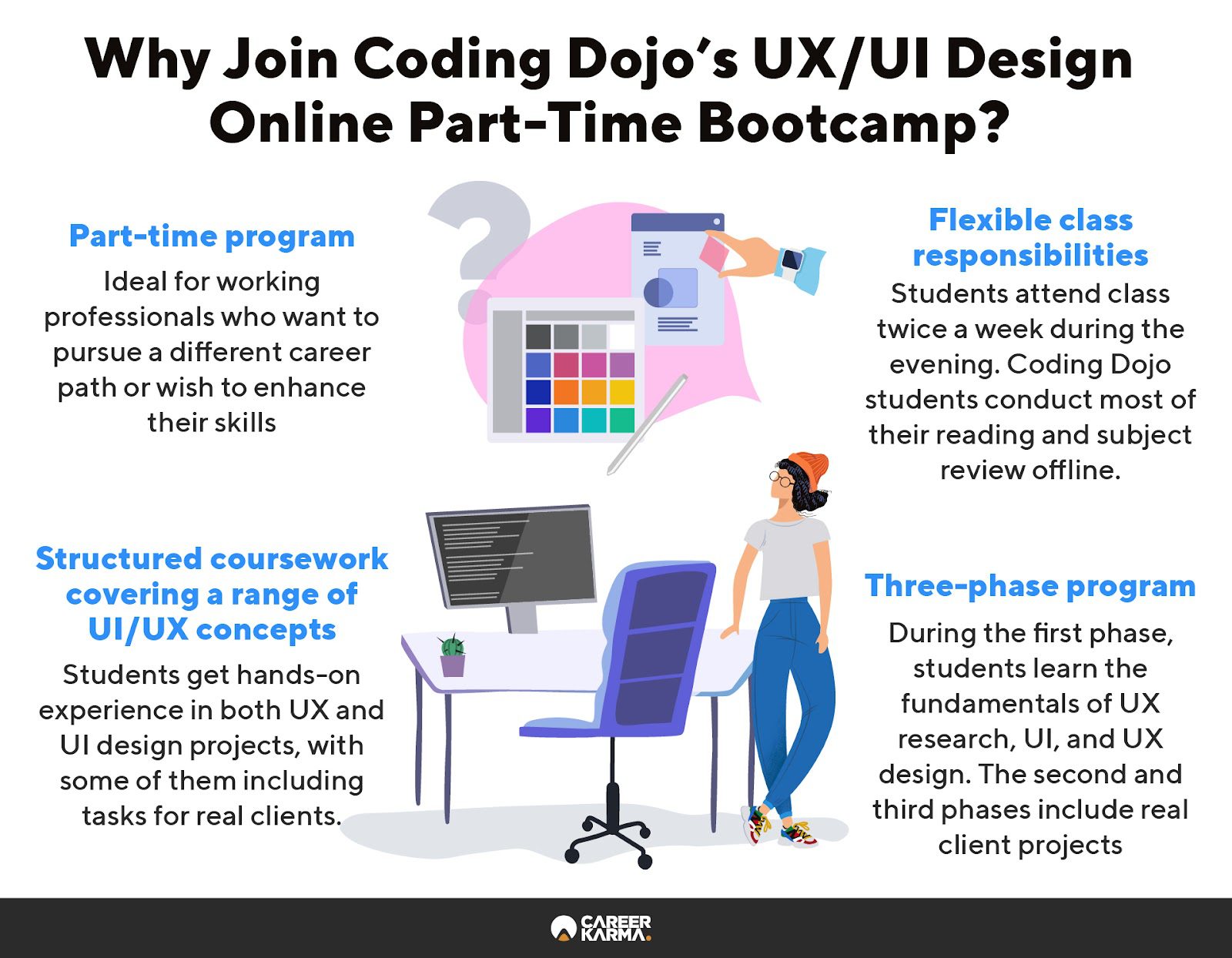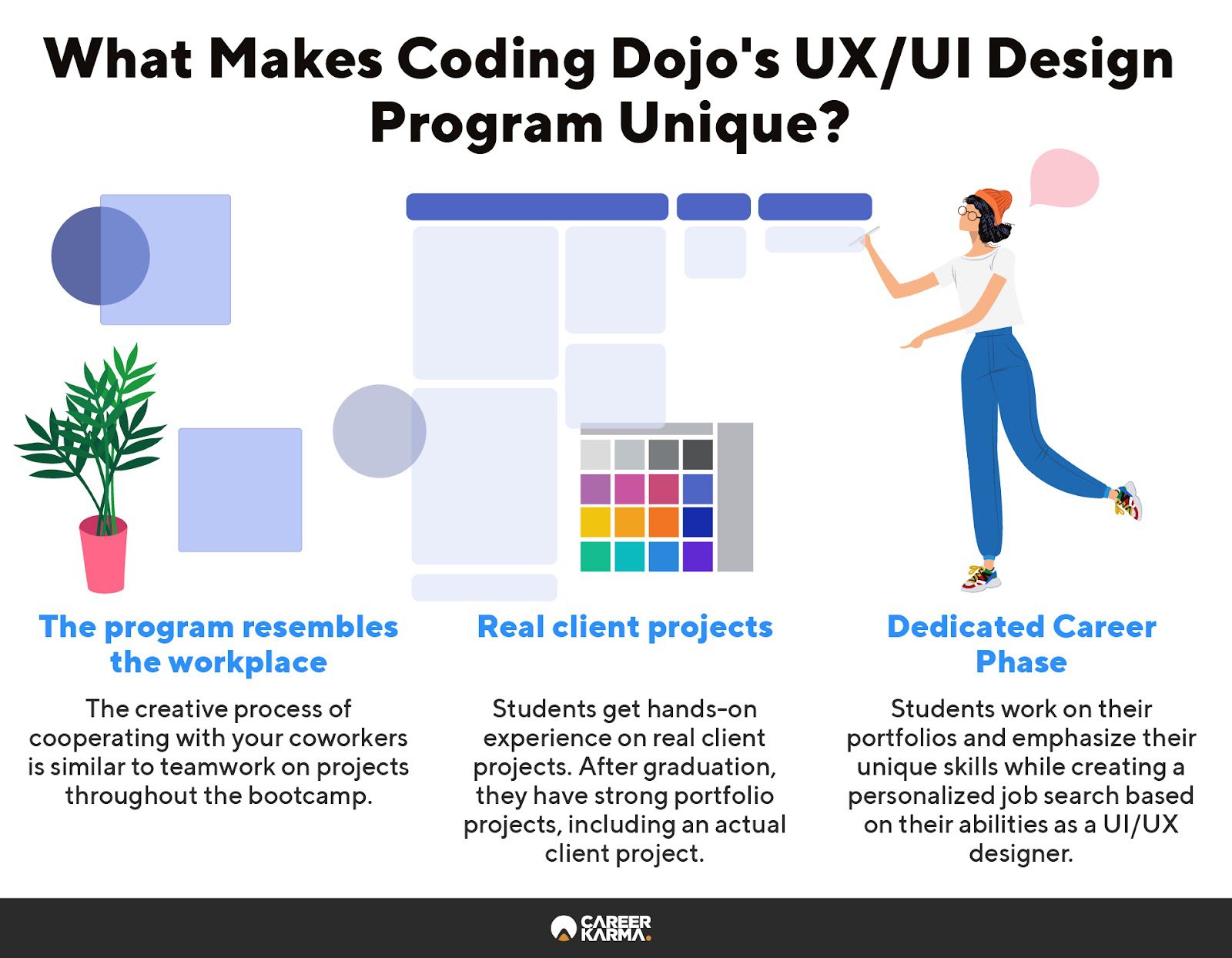Behind every winning digital product is a successful designer who has spent a lot of time and thought developing every facet of the product’s appearance and functionality. As more businesses become aware of this competitive advantage, the demand for qualified user experience (UX) and user interface (UI) designers is steadily rising.
And the tech industry is ready to offer competitive salaries to talented designers who can create software and web apps that are easy to use for larger audiences. With 4,122 job openings and an average salary of $90,942, Forbes listed UX Designer as the 24th hottest career for 2021.
Recognizing this demand, Coding Dojo, a coding bootcamp with eight years of teaching experience and over 7,000 graduates, has recently rolled out its newest addition to its growing course catalog: the part-time UX/UI design program.
Coding Dojo’s new 24-week UX/UI Design Online Part-Time program advances hands-on learning and offers a flexible schedule for parents and working professionals.
Apply to Coding Dojo today.Is a Career in UX/UI Design Right for Me?
UX and UI design are among the fields in tech that do not require hard coding skills. That said, many people have transferable skills they may be unaware of that can help them succeed in the role of UX/UI designer. If you’re thinking of pursuing a UX/UI design career, consider the following questions:
- Are you creative and technically oriented?
- Can you focus on the big picture without losing sight of the details?
- Do you have a passion for digital tools that help people?
- Do you have great communication skills?
- Do you have good time management skills?
If you answered “yes” to all or most of the above, your next step is to consider enrolling in Coding Dojo’s UX/UI part-time online program.
The course does not require prior experience in UX/UI design, although it will be beneficial to research the ins and outs of the profession and make sure you know the requirements and demands of the program before you start.
An Overview of Coding Dojo’s UX/UI Program Design

Coding Dojo’s UX/UI Design Online Part-Time program is a flexible, part-time program designed for working professionals willing to gain design skills to level up or switch their careers. The coursework is structured to give students a comprehensive experience in both UX and UI design processes.
During the 24-week UX/UI design program, students learn various research and synthesis techniques to gather and evaluate quantitative and qualitative data, create concepts, wireframes, and prototypes for live user testing. Importantly, students work with real clients, giving them professional experience before graduation.
They also craft high fidelity screens and prototypes for final evaluative tests that are portfolio-ready. Students’ hands-on projects include the use of popular design tools, such as Figma, FigJam/Miro, Zoom, GDrive, Gdocs, and others.
Coding Dojo’s UX/UI design students have part-time class commitments and attend workshops twice a week in the evening. Beyond class hours, students do most of their reading and content review offline to practice the skills they have learned in class. The estimated time for self-study is 20 to 30 hours per week.
Coding Dojo’s UX/UI Design Program Curriculum
Coding Dojo’s UX/UI design program’s innovative curriculum trains students in both UX and UI skills and techniques and evaluates their knowledge through real-world client projects. Students are in control of their design decisions, work in teams, present their findings and learn how to give and receive detailed feedback while gaining confidence and skills for the design job market.
The program is divided into three phases. During the first phase, students learn the fundamentals of UX research, UI, and UX design. This prepares learners for the second and third phases of the program, where they work on real client projects. “And that’s where we learn, UX/UI is not a set of templated processes, it’s a way of working that flexes to solve problems,” says Douglas Bantz, the lead UX/UI instructor and curriculum developer at Coding Dojo.
The curriculum consists of a two-week pre-course and 24 main curriculum modules.
- Pre-Course work (2 weeks)
- UX/UI Literacy Web/Mobile Project (11 weeks)
- Research and Synthesis (4 weeks)
- Concepting and Prototyping (3 weeks)
- Developing User Interface (4 weeks)
- Client Project (10 weeks)
- Project Specifications Scope, and Strategy (2 weeks)
- User Interview and Synthesis (3 weeks)
- Wireframing, Prototyping, and Presentations (2 weeks)
- Developing Visual Designs, High Fidelity Designs, Final Presentations (3 weeks)
- Career Phase (3 weeks)
- Personal Brand, Case Studies, and Portfolios (2 weeks)
- Getting Job Ready (1 week)
- Graduation
Why Choose Coding Dojo’s UX/UI Design Program?

Douglas highlights three features that make Coding Dojo’s UX/UI program unique: a course structure that allows for independent learning, a hands-on and practical learning approach, and built-in job search guidance.
Rigorous Training
Training at the bootcamp is rigorous. From the onset, students are treated as professional designers and expected to perform at their best. The instructors, meanwhile, act as creative directors and product managers—not there to hold your hands but to make sure you stay on track and on top of your learning.
“The structure of the curriculum is designed for people to take control of their education,” says Douglas. “We realize that you’re professionals, and we treat you like one…We’ll tell you when things are up to snuff and when they aren’t. We’re not here to waste your time and we kindly do not pull punches.”
Real-Life and Hands-On Experience
Real-life experience is a major part of Coding Dojo’s curriculum. This ensures that students leave the program ready to enter the workforce and work on real-world projects.
“Our first project is like most work you’ll tackle as a new designer. You have to work within design and business parameters; you don’t just get to make stuff up,” says Douglas. “We’ll be working on a redesign project that’s sourced from a real-world example and gets everyone up to speed in UX and UI skills.”
This serves as a primer to the second part of the program where students work and interact with a real client to develop a project. They graduate with two solid portfolio projects, including a live client project, and the confidence to tackle complex projects in the future.
Dedicated Career Phase
The last three weeks of the bootcamp focus on the career phase, which is “built on real techniques and career assets that hiring managers want to see,” says Douglas. The hope is that by the end of the program, students will not just have the key technical skills of a UX/UI designer but also the critical job search skills they’ll need to secure employment.
“We’ll help you land that first job by developing assets that get you in the door, and we’ll prepare you for that conversation with hiring managers. You’ll leave the program with a set of career tools like a design portfolio, resume, and online profile that telegraphs your skills as a designer,” says Douglas.
How to Pay for Coding Dojo’s UX/UI Design Program
The cost of tuition for Coding Dojo’s online 24-week UX/UI design program is $12,495. and students can save $250 from the tuition fees if they pay up front. Students can also choose an alternative tuition plan and pay in installments. This requires a $1,000 deposit and caps at $12,745. Installment plans carry 0 percent interest and do not require a credit check.
Aspiring UX/UI designers may also apply for a tuition loan with Climb or Ascent and qualify for a monthly payment plan starting from $208 per month to pay for their bootcamp expenses. Coding Dojo has several financing options for its students, so you can choose the one that best suits your needs.
Top Career Paths after Coding Dojo’s UX/UI Program
Below are the career paths that you can take after completing Coding Dojo’s UX/UI design bootcamp, according to Douglas.
UX Researchers
- Median salary (PayScale): $87,944
UX researchers answer the most challenging questions regarding product design to reveal what the consumers need from the business products. UX Researchers conduct primary research, explore consumer behavior, and motivation.
UX/UI Generalists
- Median salary (ZipRecruiter): $91,500
UX/UI Generalists oversee the production process from start to end. They identify and troubleshoot UX/UI problems, creating prototypes, wireframes, and mockups. UX/UI Generalists optimize UI designs, test them for user-centeredness, and identify gaps in design for its further improvement.
UI Designers
- Median salary (PayScale): $65,330
UI Designers are designers who work in interfaces, utilizing colors, fonts, pictures, and building design systems that keep organizations visually aligned. They are responsible for creating interactive programs that enhance a customer’s experience with a brand. UI designers may require some basic coding to transfer the brand’s strength through the interface of a product.
Product Designers
- Median salary (PayScale): $85,882
Product designers have UX and UI design skills, business acumen, and engage with clients more. “As a grad from Coding Dojo, we call this the second and third goal. You’ll get this position with some experience, and you’ll likely get paid more for it as you advance,” says Douglas.
Coding Dojo’s alumni work at Google, Microsoft, Amazon, TEDx, Oracle, Adobe, Disney, Uber, Hewlett Packard, and many more companies in the tech industry. Check Coding Dojo’s website for more details on its industry-leading outcomes.
Launch Your UX/UI Design Career with Coding Dojo
Coding Dojo’s UX/UI Design Online Part-Time Bootcamp helps aspiring UX/UI designers not only gain relevant design skills but also acquire the mindset of a designer. Working on real-life client projects during the bootcamp and having lifetime access to career services also help Coding Dojo grads succeed in their UX/UI design career.
If this is the kind of training you’re looking for, enroll now and be among Coding Dojo’s first cohort of UX/UI designers. If you want to learn more about this school, read our Coding Dojo review where we discuss career services, curriculum, and instructors.
About us: Career Karma is a platform designed to help job seekers find, research, and connect with job training programs to advance their careers. Learn about the CK publication.




